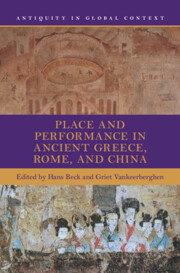Book contents
- Place and Performance in Ancient Greece, Rome, and China
- Antiquity in Global Context
- Place and Performance in Ancient Greece, Rome, and China
- Copyright page
- Contents
- Figures
- Tables
- Contributors
- Series Editors’ Preface
- Editors’ Preface
- Introduction
- Part I Crafting Space and Place
- Part II Performances of Power
- Part III Urban Places
- Chapter 7 Neighborhood Life in Imperial Rome and Han Chang’an
- Chapter 8 Society, Cities, and the Significance of ‘Sacred Roads’ in Archaic Greece, in the Chinese Qin and Han Empires, and in the Archaic States of the Middle East
- Chapter 9 Hydropolitical Engineering in Rome and Chang’an
- Chapter 10 Imperial Gardens in Early Roman and Chinese Empires
- Part IV Fringe Places and Endpoints
- Index
- References
Chapter 9 - Hydropolitical Engineering in Rome and Chang’an
Water Flows in the Shape of Power
from Part III - Urban Places
Published online by Cambridge University Press: 28 November 2024
- Place and Performance in Ancient Greece, Rome, and China
- Antiquity in Global Context
- Place and Performance in Ancient Greece, Rome, and China
- Copyright page
- Contents
- Figures
- Tables
- Contributors
- Series Editors’ Preface
- Editors’ Preface
- Introduction
- Part I Crafting Space and Place
- Part II Performances of Power
- Part III Urban Places
- Chapter 7 Neighborhood Life in Imperial Rome and Han Chang’an
- Chapter 8 Society, Cities, and the Significance of ‘Sacred Roads’ in Archaic Greece, in the Chinese Qin and Han Empires, and in the Archaic States of the Middle East
- Chapter 9 Hydropolitical Engineering in Rome and Chang’an
- Chapter 10 Imperial Gardens in Early Roman and Chinese Empires
- Part IV Fringe Places and Endpoints
- Index
- References
Summary
Jordan Christopher analyzes the freshwater provision systems of the imperial capitals of Rome and Chang’an from the perspective of political power, using as his adage that “water flows in the shape of power.” He describes how, during the Republican period, Roman aqueducts were constructed in an ad hoc manner, to please certain constituents rather than to meet the documented needs of the general public. Augustus, in contrast, had a new aqueduct (Aqua Alsietina) constructed to serve only his own Naumachia. Still, even under the Principate, Roman rulers understood that maintaining the earlier aqueducts was a political necessity, and they also invested in baths and fountains – public spaces where elite and commoners alike could meet – to promote solidarity among the citizenry. As recent archaeological work has documented, Western Han Chang’an too was equipped with impressive water control and supply systems. Water coming from the mountains south of Chang’an was pooled and channeled, and engineered so that it could both provide the city with freshwater and prevent flooding. Christopher’s point here is that, by and large, the water infrastructure served the palaces, especially the two major palaces in the southern part of Chang’an, providing a steady supply of water and beautifying the environment. In other words, instead of overcoming hierarchies, water infrastructure in Chang’an was used, just like its many walls, to reinforce and strengthen hierarchies. Chang’an also featured no fountains, and while its many (private) wells might have provided occasion for people to mingle, they were by no means designed to promote such encounters.
Keywords
- Type
- Chapter
- Information
- Place and Performance in Ancient Greece, Rome, and China , pp. 297 - 317Publisher: Cambridge University PressPrint publication year: 2024

